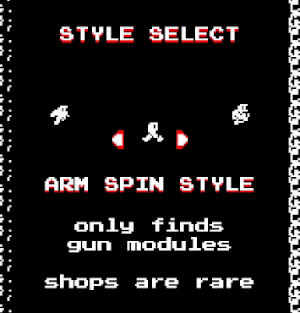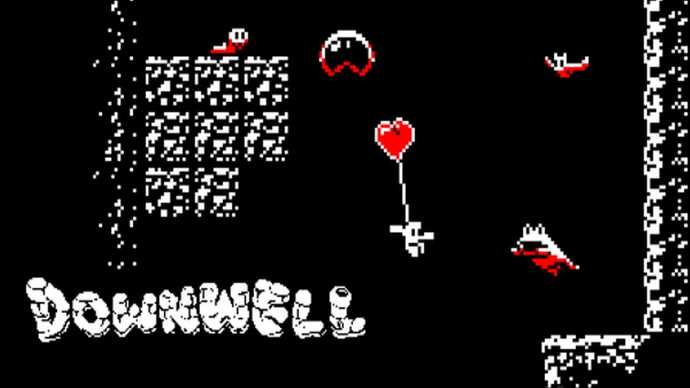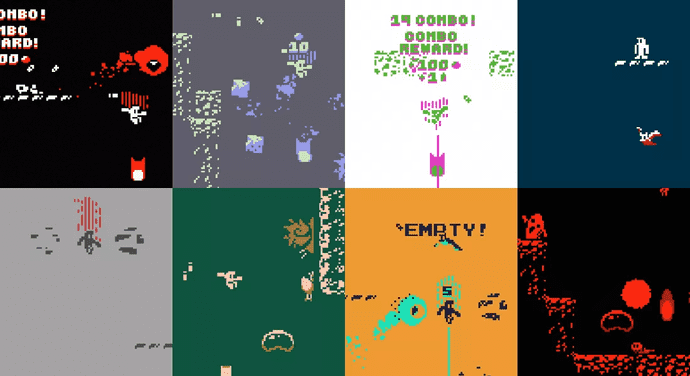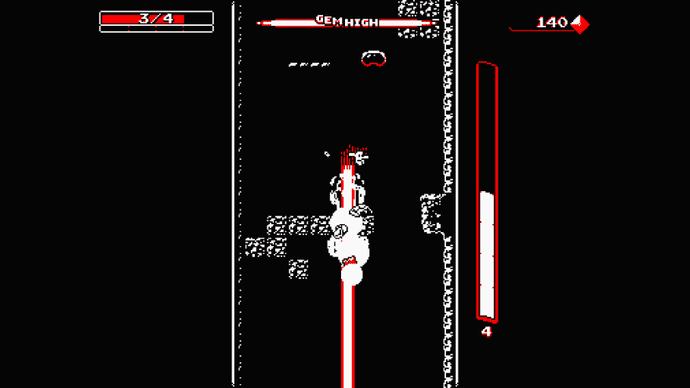The Mechanics of Downwell
At its core, Downwell is a simple game. It has all the mechanics that make other platformers seem easy to those who are used to them, but it introduces a new twist on the sideways platformer genre. Instead of going from left to right, the player traverses through the levels top to bottom. The goal of Downwell is to get to the bottom of each level by navigating through obstacles and monsters, and keeping the health bar up so you have a better chance of surviving until the end, otherwise you have to start from the beginning again. Throughout the levels, the player gets upgrades that can be necessary, but not always helpful.
The game is full of different items, mostly acquired at the end of a level or in a special area during the level. First, there are the Gunboots, which are the main item of the game and are used to shoot downwards and kill enemies. There are also gems which are the currency of the game. The player gets these through killing enemies and potentially through breaking blocks and such in the world, and they can be spent at shops which appear during the level. These shops usually have items that can be exchanged for gems, and refill the player’s health or give them more ammo in the Gunboots. Occasionally, the player will come across a special area with a Gunboots upgrade. This will give the player a bit of health or extra ammo, but change the way the Gunboots fire. There are seven of these upgrades or “modules'' that can appear. Finally, at the end of each level, the player gets to choose a character upgrade from a list of a random three. These can be things such as an extra point of health total, ability to create a safe bubble when hit by an enemy, or even a jetpack to slow the player’s fall when they run out of bullets in midair.
Gravity is one of the biggest mechanics of Downwell, since instead of going through the level left to right, the player falls from top to bottom in a quest to reach the bottom of the well. Equipped with Gunboots, the player shoots from their feet instead of from their arms, making the enemies that appear below the player possible to kill. Because not all enemies can always be killed with one shot from these Gunboots, the player tries to avoid falling very fast in order to not hit these enemies, and this is done in a few ways. The first way a player can slow down and check the terrain below them is to stand on the ledges that appear in the well. There, the player can see where would be the best place to fall next, and what enemies lie ahead so they can jump down farther and either avoid or kill these enemies. Another way a player can slow down and temporarily get a quick view of what is below them, is by shooting the Gunboots, which slows the downward momentum for a brief time. This is used to gain more control over the fall that the player is experiencing and again look at their surroundings, but this time they do not have to touch the ground and can continue falling and keep combos alive. The final and arguably most beneficial way a player can slow down their fall, is to kill an enemy that can be stomped on. Some enemies that can be stomped on give the player a slight bump upwards when jumped on, and this can be the most efficient way to slow a fall because it immediately kills the enemies below the player, adds to the current combo, AND refills the ammo on the player’s Gunboots allowing them to make more empty shots in the future to see where they are going. A series of empty shots and jumping on enemies can be incredibly hard to pull off at different levels of the game, but the falling motion and gravity make it necessary for the player to stay alive using these tactics.
The game always consists of three colors, and no more. In each of the unlockable color palettes, there are three colors so that the game is always three colors, even if they are white or black. The default color scheme is Red-Black-White, but other color palettes can be unlocked, such as Blue-Pink-White or even Red-Crimson-Black as shown below:
The colors are still recognizable, the player can usually tell which things are okay to land on and which are dangerous. This makes three distinct colors in each palette: one for the background, one for the player ground, and anything safe to jump on, and a dangerous color. An example of a place where a safe color is used is the Metroid-like enemies that float around. Their tops are the same color as the player and the ground, indicating that it is okay to land on them to stomp and kill them. This also applies to bats, who are only danger colored on the bottom. Examples of danger colored (not player or background colored) are the spiked snail like enemies, and the eyeball enemy shown in the top left picture. The color schemes give the game an interesting twist, as they can be used to give more of a challenge on harder to see palettes.
The upgrade system in the game sometimes makes the player sacrifice some of the “easier” gun modules for harder ones. Whenever the player gets a gun module, they either get a boost to their health or ammo, but they have to use the gun module that comes with the boost until they can get another one. For example, a player might go from having 8 bullets in Machine gun mode, but then they find a Laser that provides them an extra health point, but only allows them 2 shots from their current clip, as laser requires 4 ammo for one shot. Lasers are more powerful and the player gets the benefit of health, but they get less shots per clip, so it is more risky. All of the gun modules are designed like this, some are easier to use, but if the player is really in a bind and needs health, they might have to pick up a gun module they don’t normally like to use.

Finally, there is the mechanic of “styles”. These styles change things about how the world generates and what happens to the player. For example, besides the Usual style, there is the style called Arm Spin, which causes the world to only generate gun module rooms, and makes shops very rare, so in this mode, most of the player’s health is gained from choosing gun modules and revolves around which gun module the player currently has. There is also Boulder style, which increases the player’s total health, but decreases the amount of upgrades they can choose from at the end of a level. These styles give advantages and disadvantages that a player can use to their benefit, for example if they are good with all the gun modules, then Arm Spin would be good to choose, because it revolves heavily around upgrades acquired through the gun modules.
Overall, the mechanics and aesthetics of Downwell are mainly about survival. Choosing the best upgrade for your style of play, choosing the right modules and spending gems wisely to regain health or more ammo are all vital to your long term survival in a round of this game.


